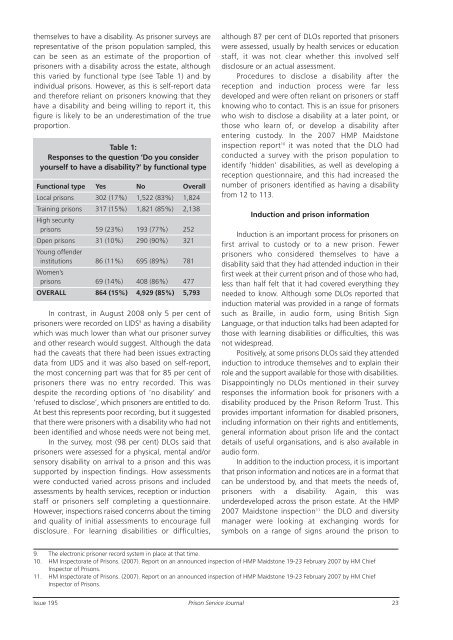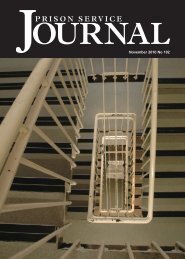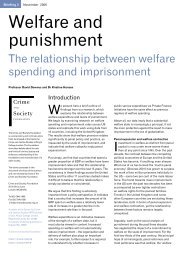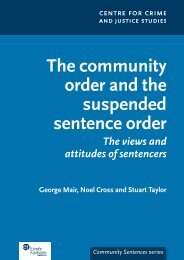Focus on Disability
Focus on Disability
Focus on Disability
Create successful ePaper yourself
Turn your PDF publications into a flip-book with our unique Google optimized e-Paper software.
themselves to have a disability. As pris<strong>on</strong>er surveys are<br />
representative of the pris<strong>on</strong> populati<strong>on</strong> sampled, this<br />
can be seen as an estimate of the proporti<strong>on</strong> of<br />
pris<strong>on</strong>ers with a disability across the estate, although<br />
this varied by functi<strong>on</strong>al type (see Table 1) and by<br />
individual pris<strong>on</strong>s. However, as this is self-report data<br />
and therefore reliant <strong>on</strong> pris<strong>on</strong>ers knowing that they<br />
have a disability and being willing to report it, this<br />
figure is likely to be an underestimati<strong>on</strong> of the true<br />
proporti<strong>on</strong>.<br />
Table 1:<br />
Resp<strong>on</strong>ses to the questi<strong>on</strong> ‘Do you c<strong>on</strong>sider<br />
yourself to have a disability?’ by functi<strong>on</strong>al type<br />
Functi<strong>on</strong>al type Yes No Overall<br />
Local pris<strong>on</strong>s 302 (17%) 1,522 (83%) 1,824<br />
Training pris<strong>on</strong>s 317 (15%) 1,821 (85%) 2,138<br />
High security<br />
pris<strong>on</strong>s 59 (23%) 193 (77%) 252<br />
Open pris<strong>on</strong>s 31 (10%) 290 (90%) 321<br />
Young offender<br />
instituti<strong>on</strong>s 86 (11%) 695 (89%) 781<br />
Women’s<br />
pris<strong>on</strong>s 69 (14%) 408 (86%) 477<br />
OVERALL 864 (15%) 4,929 (85%) 5,793<br />
In c<strong>on</strong>trast, in August 2008 <strong>on</strong>ly 5 per cent of<br />
pris<strong>on</strong>ers were recorded <strong>on</strong> LIDS 9 as having a disability<br />
which was much lower than what our pris<strong>on</strong>er survey<br />
and other research would suggest. Although the data<br />
had the caveats that there had been issues extracting<br />
data from LIDS and it was also based <strong>on</strong> self-report,<br />
the most c<strong>on</strong>cerning part was that for 85 per cent of<br />
pris<strong>on</strong>ers there was no entry recorded. This was<br />
despite the recording opti<strong>on</strong>s of ‘no disability’ and<br />
‘refused to disclose’, which pris<strong>on</strong>ers are entitled to do.<br />
At best this represents poor recording, but it suggested<br />
that there were pris<strong>on</strong>ers with a disability who had not<br />
been identified and whose needs were not being met.<br />
In the survey, most (98 per cent) DLOs said that<br />
pris<strong>on</strong>ers were assessed for a physical, mental and/or<br />
sensory disability <strong>on</strong> arrival to a pris<strong>on</strong> and this was<br />
supported by inspecti<strong>on</strong> findings. How assessments<br />
were c<strong>on</strong>ducted varied across pris<strong>on</strong>s and included<br />
assessments by health services, recepti<strong>on</strong> or inducti<strong>on</strong><br />
staff or pris<strong>on</strong>ers self completing a questi<strong>on</strong>naire.<br />
However, inspecti<strong>on</strong>s raised c<strong>on</strong>cerns about the timing<br />
and quality of initial assessments to encourage full<br />
disclosure. For learning disabilities or difficulties,<br />
although 87 per cent of DLOs reported that pris<strong>on</strong>ers<br />
were assessed, usually by health services or educati<strong>on</strong><br />
staff, it was not clear whether this involved self<br />
disclosure or an actual assessment.<br />
Procedures to disclose a disability after the<br />
recepti<strong>on</strong> and inducti<strong>on</strong> process were far less<br />
developed and were often reliant <strong>on</strong> pris<strong>on</strong>ers or staff<br />
knowing who to c<strong>on</strong>tact. This is an issue for pris<strong>on</strong>ers<br />
who wish to disclose a disability at a later point, or<br />
those who learn of, or develop a disability after<br />
entering custody. In the 2007 HMP Maidst<strong>on</strong>e<br />
inspecti<strong>on</strong> report 10 it was noted that the DLO had<br />
c<strong>on</strong>ducted a survey with the pris<strong>on</strong> populati<strong>on</strong> to<br />
identify ‘hidden’ disabilities, as well as developing a<br />
recepti<strong>on</strong> questi<strong>on</strong>naire, and this had increased the<br />
number of pris<strong>on</strong>ers identified as having a disability<br />
from 12 to 113.<br />
Inducti<strong>on</strong> and pris<strong>on</strong> informati<strong>on</strong><br />
Inducti<strong>on</strong> is an important process for pris<strong>on</strong>ers <strong>on</strong><br />
first arrival to custody or to a new pris<strong>on</strong>. Fewer<br />
pris<strong>on</strong>ers who c<strong>on</strong>sidered themselves to have a<br />
disability said that they had attended inducti<strong>on</strong> in their<br />
first week at their current pris<strong>on</strong> and of those who had,<br />
less than half felt that it had covered everything they<br />
needed to know. Although some DLOs reported that<br />
inducti<strong>on</strong> material was provided in a range of formats<br />
such as Braille, in audio form, using British Sign<br />
Language, or that inducti<strong>on</strong> talks had been adapted for<br />
those with learning disabilities or difficulties, this was<br />
not widespread.<br />
Positively, at some pris<strong>on</strong>s DLOs said they attended<br />
inducti<strong>on</strong> to introduce themselves and to explain their<br />
role and the support available for those with disabilities.<br />
Disappointingly no DLOs menti<strong>on</strong>ed in their survey<br />
resp<strong>on</strong>ses the informati<strong>on</strong> book for pris<strong>on</strong>ers with a<br />
disability produced by the Pris<strong>on</strong> Reform Trust. This<br />
provides important informati<strong>on</strong> for disabled pris<strong>on</strong>ers,<br />
including informati<strong>on</strong> <strong>on</strong> their rights and entitlements,<br />
general informati<strong>on</strong> about pris<strong>on</strong> life and the c<strong>on</strong>tact<br />
details of useful organisati<strong>on</strong>s, and is also available in<br />
audio form.<br />
In additi<strong>on</strong> to the inducti<strong>on</strong> process, it is important<br />
that pris<strong>on</strong> informati<strong>on</strong> and notices are in a format that<br />
can be understood by, and that meets the needs of,<br />
pris<strong>on</strong>ers with a disability. Again, this was<br />
underdeveloped across the pris<strong>on</strong> estate. At the HMP<br />
2007 Maidst<strong>on</strong>e inspecti<strong>on</strong> 11 the DLO and diversity<br />
manager were looking at exchanging words for<br />
symbols <strong>on</strong> a range of signs around the pris<strong>on</strong> to<br />
9. The electr<strong>on</strong>ic pris<strong>on</strong>er record system in place at that time.<br />
10. HM Inspectorate of Pris<strong>on</strong>s. (2007). Report <strong>on</strong> an announced inspecti<strong>on</strong> of HMP Maidst<strong>on</strong>e 19-23 February 2007 by HM Chief<br />
Inspector of Pris<strong>on</strong>s.<br />
11. HM Inspectorate of Pris<strong>on</strong>s. (2007). Report <strong>on</strong> an announced inspecti<strong>on</strong> of HMP Maidst<strong>on</strong>e 19-23 February 2007 by HM Chief<br />
Inspector of Pris<strong>on</strong>s.<br />
Issue 195 Pris<strong>on</strong> Service Journal<br />
23











